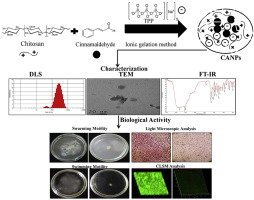LWT - Food Science and Technology ( IF 6.0 ) Pub Date : 2018-08-04 , DOI: 10.1016/j.lwt.2018.08.011 Pattnaik Subhaswaraj , Subhashree Barik , Chandrasekhar Macha , Potu Venkata Chiranjeevi , Busi Siddhardha

|
The encapsulation of cinnamaldehyde into biodegradable polymeric systems represents a possible strategy to overcome the bioavailability issues and enhance the sustained release of the drug at the target sites. In the present study, the efficacy of cinnamaldehyde encapsulated chitosan nanoparticles (CANPs) in attenuating the quorum sensing (QS) regulated virulence of P. aeruginosa PAO1 was investigated. CANPs were synthesized by ionic gelation method, characterized by dynamic light scattering (DLS), and transmission electron microscopic (TEM) analysis. The DLS and TEM analysis confirmed the synthesis of CANPs with a mean diameter of 208.12 nm. The encapsulation efficiency was observed to be 65.04 ± 3.14% and in vitro release study confirmed the slow and sustained release of cinnamaldehyde. CANPs showed significant anti quorum sensing activity by down regulating the QS regulated virulence factors and associated biofilm formation as evidenced from microscopic observation. CANPs also significantly altered the swimming and swarming motility of P. aeruginosa PAO1. The present results suggested the greater prospective of the application of CANPs as potential anti quorum sensing agents as compared to native cinnamaldehyde and suggested new avenues for development of novel anti-infective agents in the post antibiotic era.
中文翻译:

肉桂醛包埋的壳聚糖纳米粒对铜绿假单胞菌PAO1的抗群体感应和抗生物膜功效
将肉桂醛包封到可生物降解的聚合物体系中是一种可能的策略,可克服生物利用度问题并增强药物在靶部位的持续释放。在本研究中,研究了肉桂醛包封的壳聚糖纳米颗粒(CANPs)在减弱铜绿假单胞菌PAO1的群体感应(QS)调控的毒力中的功效。通过离子凝胶法合成CANPs,其特征在于动态光散射(DLS)和透射电子显微镜(TEM)分析。DLS和TEM分析证实了平均直径为208.12 nm的CANP的合成。体外观察到包封率是65.04±3.14%释放研究证实了肉桂醛的缓慢和持续释放。CANPs通过下调QS调节的毒力因子和相关的生物膜形成而显示出显着的抗群体感应活性,这从显微镜观察中可以看出。CANPs也显着改变了铜绿假单胞菌PAO1的游泳和成群运动能力。目前的结果表明,与天然肉桂醛相比,CANS作为潜在的抗群体感应剂的应用前景更大,并为抗生素时代后的新型抗感染剂的开发提供了新途径。











































 京公网安备 11010802027423号
京公网安备 11010802027423号